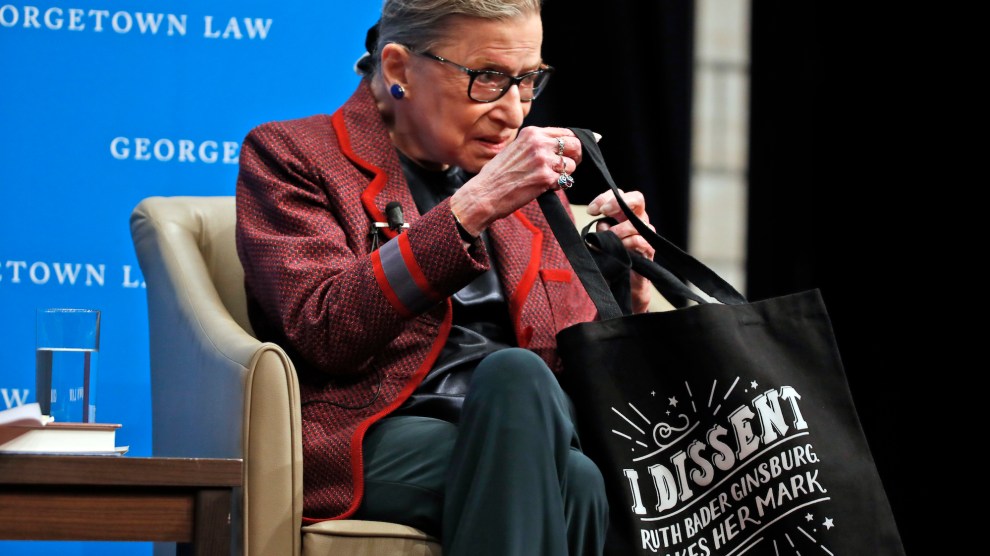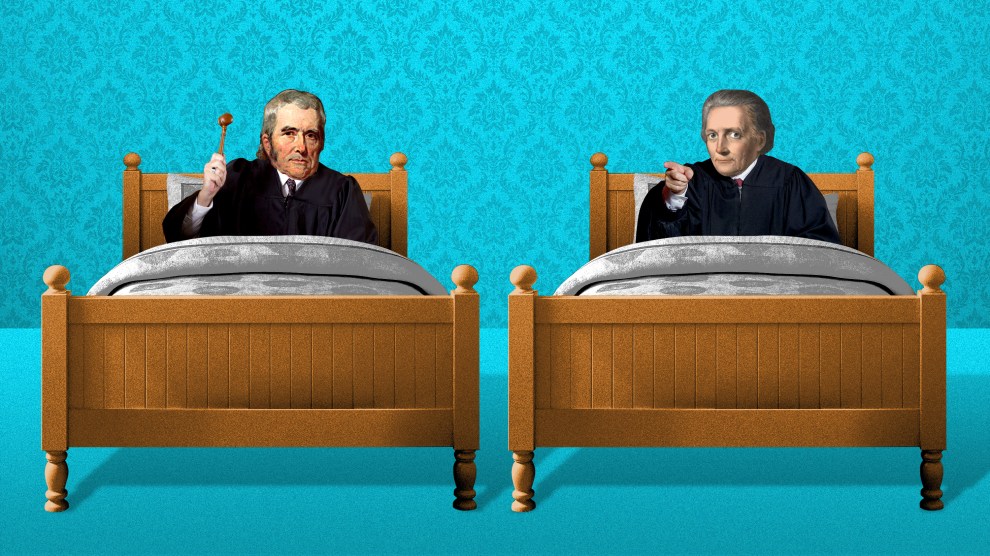
Supreme Court Justice Ruth Bader Ginsburg places some items in her bag before speaking at Georgetown Law School, Friday, April 6, 2018, in Washington. Alex Brandon/AP Photo
On the Basis of Sex, a feature film on the pioneering legal work of Supreme Court Justice Ruth Bader Ginsburg, is due to roll out in theaters nationwide on Christmas Day. With Felicity Jones’ portrayal of Ginsburg as a hot, young ACLU lawyer, the canonization of “Notorious RGB” will be officially complete. The 85-year-old justice’s celebrity status as a badass feminist has never been higher. CNN, which earlier this year produced a Ginsburg documentary titled RBG, has declared her the “face of the resistance” against President Donald Trump’s agenda, and a new Ginsburg biography was published in October to coincide with the 25th anniversary of her confirmation. A retail store opened recently in Washington, DC, stocked almost exclusively with RBG merch: yoga mats, water bottles, T-shirts, action figures, magnets, and pins designed to look like Ginsburg’s lace “dissent collar.” The store is called The Outrage.
But no amount of swag or hagiography can obscure the fact that, while Ginsburg is responsible for a great number of landmark legal decisions, her legacy may be sorely tarnished by one truly terrible one: refusing to retire when President Barack Obama could have named her replacement. That decision came into stark relief this month when Ginsburg fell and broke three ribs—and half of the nation took a collective gasp. Women took to Twitter to offer the justice a rib.
Irin Carmon, a co-author of Ginsburg fan-book The Notorious RBG who is as responsible as anyone else for the contemporary Cult of Ginsburg, encouraged devotees not to freak out. Their hero is resilient, indestructible even, Carmon insisted. Ginsburg has survived cancer—twice!—and still has never missed a day on the bench. “I am not RBG’s doctor, but I am one of her biographers, here to testify to her resilience,” Carmon wrote in The Cut. To reinforce her point, Carmon interviewed Bryant Johnson, Ginsburg’s longtime personal trainer, who said, “To all the stressed-out people in America, remember that the justice is TAN. Now, I always use that acronym: TAN. She’s tough as nails. You think three ribs are going to stop Justice?”
But Carmon and others who’ve helped turn Ginsburg into a pop-culture icon are deluding themselves. Ginsburg is a mere mortal. Falling down is the leading cause of accidental death in people over age 85. The actuarial table is not in her favor. There’s a real possibility Ginsburg will not outlast the Trump administration or live long enough for a Democrat to replace her. The situation today is one many liberal lawyers feared years ago and worked hard to avert. But the feisty justice rebuffed them all, a decision that makes all the hero worship hard for some of us to stomach.
The calls for Ginsburg to step down began in 2011 when Randall Kennedy, a Harvard law professor and former clerk to the late Thurgood Marshall, wrote a piece in The New Republic gently urging Ginsburg, then 78, to retire while Obama was in office. (He had suggested the same of Justice Stephen Breyer, now 80.) Kennedy was publicly airing private concerns among Democrats that it could be Ginsburg’s last chance to be replaced by a Democrat. “Justices Ginsburg and Breyer have enriched the nation with long, productive, admirable careers,” he wrote. “Those, like me, who admire their service might find it hard to hope that they will soon leave the Court—but service comes in many forms, including making way for others.”
Kennedy held up his old boss as a cautionary tale. Marshall’s health problems forced him to retire during the administration of George H.W. Bush, who replaced the legendary civil rights lawyer with Clarence Thomas, a conservative ideologue who has spent his 27 years on the bench working to unravel virtually everything Marshall fought for. “[I]f Justice Ginsburg departs the Supreme Court with a Republican in the White House,” Kennedy wrote, “it is probable that the female Thurgood Marshall will be replaced by a female Clarence Thomas.”
Ginsburg declined the advice and might well have used the line deployed by Felicity Jones in a scene from On the Basis of Sex, wherein the young Ginsburg tells the ACLU’s legal director: “You don’t get to tell me when to quit.”
After Obama’s 2012 reelection, the Ginsburg retirement calls came with a new urgency. In December 2013, the National Journal ran a piece titled, Justice Ginsburg: Resign Already!, in which writer James Oliphant observed that the passage of Obamacare would likely hand Senate control to the Republicans in 2014, thus preventing Obama from naming a Ginsburg successor. His concerns were echoed by prominent liberal legal scholars, notably Erwin Chemerinsky, now dean of the University of California-Berkeley law school, who wrote in early 2014 in the Los Angeles Times, “I do not minimize how hard it will be for Justice Ginsburg to step down from a job that she loves and has done so well since 1993. But the best way for her to advance all the things she has spent her life working for is to ensure that a Democratic president picks her successor.”
In response to the retirement calls (mostly from men), Ginsburg gave an interview to the New York Times’ Adam Liptak laying out the reasons she planned to ignore them. “There will be a president after this one and I’m hopeful that that president will be a fine president,” she said. Ginsburg added that she planned to keep working “as long as I can do the job full steam.” The only evidence she could see that she’d slowed down by her age, she said, was that she’d given up water-skiing and horseback riding.
In retrospect, it doesn’t seem like a coincidence that the making of Notorious RBG happened at a time when many liberals were begging her to step down. The canonization began in 2013, after Ginsburg issued a furious dissent in Shelby County v. Holder, a case that gutted a big chunk of the Voting Rights Act. Inspired, New York University law student Shana Knizhnik launched a “Notorious R.B.G” Tumblr. The meme took off and ultimately led to a 2015 book, Notorious RBG: The Life and Times of Ruth Bader Ginsburg, which Knizhnik co-authored with fellow fangirl Carmon, then an MSNBC reporter.
Ginsburg has since been tattooed on women’s arms, immortalized in song and a children’s book, and featured on SNL. She’s had her face plastered on everything from tote bags to water bottles. This merchandising could not have happened without the justice’s blessing; the law gives her a fair amount of control over the use of her image, as she well knows. Rather than start copyright battles, Ginsburg has encouraged her cult following. She assisted Carmon and Knizhnik with their book, appeared in the CNN documentary and makes a cameo in On the Basis of Sex, carries an RBG tote bag in public, distributes RBG T-shirts to friends and admirers, and generally has reveled in her celebrity.
Perhaps the savviest element of Ginsburg’s pushback against calls for her retirement is the promotion of her workout regime. Details of it appear in Notorious RBG, and Ginsburg allowed the RBG documentary makers to film her doing pushups and tossing a medicine ball—proof, the film implies, that she is nowhere near death’s door.
Last year, personal trainer Johnson published The RBG Workout: How She Stays Strong and You Can Too, for which Ginsburg wrote the foreword. In March, Ginsburg helped promote the book by going on TV to work out with Stephen Colbert wearing one of the “Super Diva” shirts Thompson sells on his website. Only the most die-hard superfan could call Ginsburg’s Colbert performance anything but cringeworthy—those things she does with Johnson are most definitely not pushups. The episode felt like a desperate attempt to convince the world, and maybe Ginsburg herself, that she didn’t grievously miscalculate in refusing to retire before 2014.
Yet her fans keep pointing to the piddly elbow bounces she calls pushups as evidence of strength and vitality, despite all the evidence that Ginsburg is a frail old woman whose health has long been of concern. In 1999, she underwent major surgery, chemotherapy, and radiation to treat colon cancer. Ten years later, she was diagnosed with early stage pancreatic cancer, for which she also had surgery. In 2014, she went to the hospital after suffering chest pains during one of her famous workouts and discovered she had a blocked artery—doctors put in a stent. When she fell and broke her ribs earlier this month, it was for the third time since 2012.
Ginsburg’s turn as an unlikely pop culture heroine has been facilitated by social media, but it could never have happened were cameras allowed in the Supreme Court. If you pay attention to Ginsburg’s public appearances, it’s pretty clear many are carefully stage managed; video of her is tactfully edited. She’s usually shown sitting graciously in a chair, or linking arms with someone as she walks, as though from affection and not from need. But in the courtroom, away from the cameras, she projects a very different image—the one that probably inspired all those liberal lawyers to her call for her timely retirement seven years ago.
About a week before her latest fall, I sat through a pair of tedious Supreme Court arguments about arbitration, so I got to see the Ginsburg most Americans do not. She was engaged in the arguments, but her speech is increasingly difficult to understand. As has long been the case, people strained to listen when she asked a question—a hot bench went quiet.
When a Supreme Court session adjourns, the public isn’t allowed to depart until all the justices have left the bench. After the arbitration arguments were gaveled to a close, I got up to leave with the rest of the onlookers. But then everyone stopped. All of the justices had left except for Ginsburg, who was having trouble getting out of her chair. There was an embarrassed silence as members of the press, the bar, and the public tried not to gape as Ginsburg mustered the courage to descend a single step off the bench and finally disappeared behind the red curtain. The contrast between the real-world Ginsburg and the comic-book superheroine of social media was striking.
Yet back in 2013, when the drumbeat for Ginsburg’s retirement was at a fevered pitch, Emily Bazelon wrote in Slate that urging the then 80-year-old cancer survivor to retire was perhaps sexist and counterproductive. Dahlia Lithwick, also in Slate, argued that it was insulting to suggest that Ginsburg, who remained so sharp on the bench, was “determinedly unaware of the political world she inhabits.”
But Ginsburg has long suffered from the inability to know when it’s time to stop working. In RBG, her beloved late husband, Marty, says the only advice he ever gave her during their five decades of marriage was about when to eat, when to stop working, and when to go to bed. Ginsburg is famous for pulling all-nighters—a habit that might have worked for her as a twentysomething student and mother. But as a senior citizen, the impact of her night-owl work habits is painfully obvious.
It’s not considered polite to point this out, but Ginsburg has been falling asleep on the bench during oral arguments for years. Back in 2006, she dozed off during a redistricting argument for a good 15 minutes—long enough for the courtroom artist to sketch her in repose. The Washington Post’s Dana Milbank wrote, “It’s lucky for Ginsburg that the Supreme Court has so far refused to allow television in the courtroom, for her visit to the land of nod would have found its way onto late-night shows.”
It’s not just oral arguments that are a problem. Ginsburg fell asleep during two of Obama’s State of the Union addresses and during Pope Francis’s 2015 speech to Congress—Justice Sonia Sotomayor had to give her a nudge to wake her up. If Ginsburg can’t put herself to bed at a reasonable hour to avoid falling asleep in public—a basic function of her job—what makes anyone so sure that her judgement about retirement was any more realistic?
In March 2014, with the window for Obama replacing Ginsburg closing quickly, Lithwick published a Slate commentary headlined, Ruth Bader Ginsburg Is Irreplaceable. All You Liberals Trying to Push Her Out, Think About That. Liberals, Lithwick wrote, were wrong to suggest that anyone could truly fill Ginsburg’s tiny shoes: “Telling her that her work is awesome, but it’s time to move on, is tantamount to saying that a liberal is a liberal and that Ginsburg brings nothing to the table that another Obama appointee will not replicate.”
Ginsburg is undoubtedly one of a kind, but that doesn’t mean other people with equally compelling personal stories couldn’t become historic members of the high court. Indeed, as Jane Sherron De Hart’s new biography makes clear, Ginsburg did not start out on the court as the liberal firebrand she’s known as today. Her nomination was nearly scuttled because feminists thought Ginsburg, with her incremental approach to social justice, was too conservative.
There are many historic firsts still awaiting the Supreme Court: first black woman, first Asian justice, first openly gay justice, etc. Ginsburg was a trailblazer, but she is not the only one. There’s no better evidence than Justice Sonia Sotomayor, the first Latina justice. Over the past decade, Sotomayor has proven to be a forceful voice for critical criminal justice issues that not even Ginsburg has championed during her tenure—notably police misconduct, an area where the Supreme Court jurisprudence has been particularly abominable.
Watch Ginsburg in RBG, the documentary, and it’s hard to be anything but charmed. She’s cute, she’s brilliant, she’s cool. Even the late liberal scourge Justice Antonin Scalia adored her. But how cute will we find Ginsburg if she becomes incapacitated and Trump replaces her with someone like 46-year-old social conservative Amy Coney Barrett, who believes life begins at conception and doesn’t really believe the Supreme Court must uphold precedent like Roe v Wade? A 6-3 conservative majority would push the court yet further to the right and eliminate any possibility that a sitting conservative such as Chief Justice John Roberts might serve as a moderating force and occasionally join with the liberal bloc to preserve critical rights and precedent.
The RBG action figures and the pushup videos will be a paltry balm for the damage likely to be done to racial equality, LGBT rights, and reproductive freedoms if Trump is allowed to replace Ginsburg. By refusing to gracefully transition off the court when Obama could have named her successor, she has raised the very real risk of her seat being filled by someone who will spend a generation trying to undo all she worked for.
If that happens, RBG will become truly notorious.













